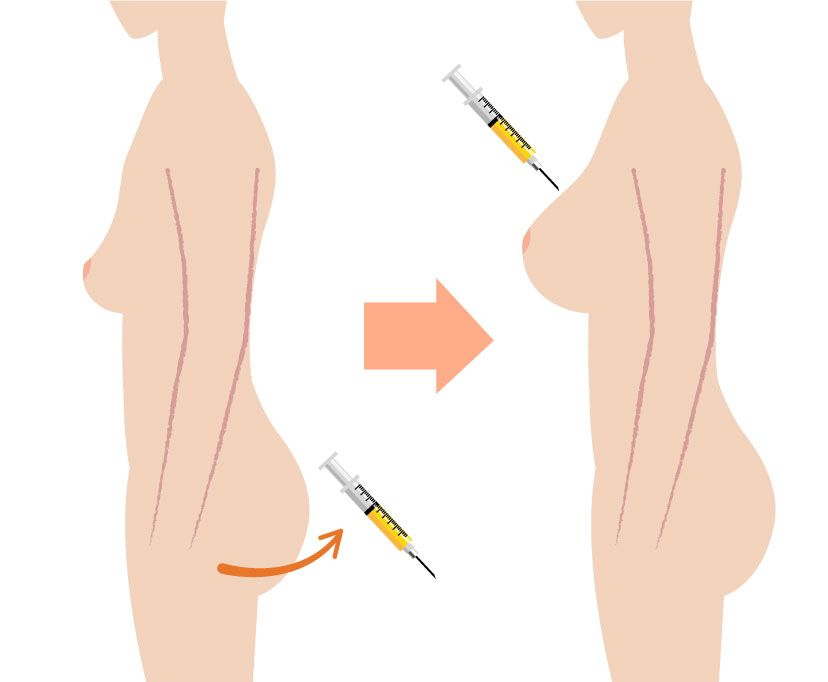Fat transfer breast augmentation offers a natural alternative to traditional implants in plastic surgery for good candidates. Many women desire fuller breasts but want to avoid synthetic materials like plastic, opting for fat augmentation surgery, fat transfer surgery, or a fat grafting procedure. This natural breast augmentation surgery uses your own body fat, making it a unique breast augmentation method for enhancing your curves.
Unlike implants used in breast augmentation surgery, which can lead to complications or require replacements, fat transfer is generally safer and more appealing as a breast augmentation method. It not only increases breast size through fat transfer surgery but also contours areas like the abdomen or thighs with structural fat grafting, giving double the benefits. With minimal downtime and a more natural feel, this breast reconstruction method is gaining popularity in the breast augmentation journey. Understanding the process of structural fat grafting and its advantages can help you make an informed choice about breast enhancement.
What is Fat Transfer Breast Augmentation
Procedure Overview
Fat transfer breast augmentation uses fat from the patient’s own body to enhance breast size. This method provides a natural alternative to implants. The procedure begins with liposuction. Surgeons remove fat from areas such as the abdomen, thighs, or hips. They typically use a small tube called a cannula for this breast fat transfer process. This technique minimizes scarring and recovery time.
Surgeons then purify the extracted fat cells. They separate viable fat from other materials. Once purified, the fat is ready for injection. The surgeon injects these fat cells into specific areas of the breasts. This creates a fuller appearance that feels natural. Patients often prefer this breast augmentation journey due to its organic results from breast fat transfer.
Benefits of Fat Transfer
Fat transfer breast enlargement offers several advantages over traditional implants. First, it uses the patient’s own tissue in breast fat transfer, reducing the risk of rejection in their breast augmentation journey. Second, it provides a more natural feel compared to synthetic implants. Many patients appreciate that the results look and feel authentic.
Another benefit includes less downtime after surgery. Recovery tends to be quicker than with implants. Patients can often return to regular activities within a week. There are no visible scars on the breasts since the liposuction incisions are small.
Considerations Before Surgery
Consultation with a qualified fat transfer breast augmentation doctor is crucial. They assess whether a patient is a good candidate for this procedure. Factors include overall health and body fat percentage. Not all patients have enough excess fat for effective transfer.
Patients should also consider their expectations. While results are generally positive, they may vary from person to person. Some might need multiple sessions to achieve desired outcomes. Discussing these factors beforehand helps set realistic goals.
Recovery Process
Post-surgery care is essential for optimal results. Patients usually experience some swelling and bruising in both the donor and recipient areas. These symptoms typically subside within two weeks. Following the surgeon’s instructions can help manage discomfort.
Wearing a supportive bra helps maintain shape during recovery. Avoiding strenuous activities for at least four weeks is recommended. This allows time for healing and ensures the injected fat settles properly.
In summary, fat transfer breast augmentation offers a unique way to enhance breast size using one’s own body fat. It combines liposuction and injection techniques for natural-looking results. Patients should consult with experienced professionals to understand their options fully.
What is Breast Augmentation
Definition
Breast augmentation is a cosmetic surgery aimed at increasing breast size and improving shape. Many women seek this procedure for various reasons. Some desire a fuller appearance, while others want to restore volume after weight loss or pregnancy.
Breast augmentations can enhance self-esteem and body image. This surgery is commonly referred to as a “boob job” in everyday language. Women often feel more confident after undergoing this procedure.
Methods
Two main methods exist for breast enhancement: breast implants and fat transfer techniques. Implants involve placing silicone or saline-filled devices under the breast tissue. These implants come in different shapes and sizes, allowing for customized results.
Fat transfer, on the other hand, involves using the patient’s own fat. Surgeons remove fat from areas like the abdomen or thighs through liposuction. The extracted fat is then injected into the breasts. This method offers a more natural look and feel.
Natural breast augmentation is gaining popularity among patients. Many prefer it due to its reduced risk of complications compared to implants. It avoids potential issues with implant replacement in the future.
Candidates
Not every woman is a suitable candidate for breast augmentation surgery. Ideal candidates are typically healthy individuals who have realistic expectations. They should not smoke and must be at least 18 years old for implants.
Patients considering this procedure should discuss their goals with a skilled surgeon. The surgeon will evaluate their medical history and overall health before proceeding.
Recovery
Recovery from breast augmentation varies by method used. Patients who opt for implant breast augmentation usually take longer to heal than those who choose natural breast enhancement.
Most women can return to light activities within a week after surgery. However, strenuous exercise may require several weeks of rest.
Surgeons often provide detailed post-operative care instructions. Following these guidelines is crucial for optimal recovery and results.
Risks
Like all surgeries, breast procedures carry some risks. Common complications include infection, scarring, and changes in nipple sensation. Fat transfer also has specific risks, such as fat necrosis, where some injected fat does not survive.
Patients should weigh these risks against the benefits before deciding on breast augmentation. Consulting with experienced professionals can help ensure informed choices.
Types of Breast Augmentation
Implant-Based
Implant-based augmentation is the most common method. This technique uses silicone or saline implants to enhance breast size and shape. Silicone implants feel more like natural breast tissue. They come pre-filled with a gel that mimics the softness of real breasts. Saline implants, on the other hand, are filled with sterile saltwater. They can be adjusted during surgery for a more tailored fit.
Surgeons place these implants under the breast tissue or chest muscle. The choice between silicone and saline often depends on personal preference and body type. Many women choose silicone for its natural feel. Others may prefer saline because it requires smaller incisions.
Fat Transfer
Fat transfer augmentation offers a different approach. This method uses the patient’s own fat to enhance breast volume. Surgeons first perform liposuction to remove fat from areas like the abdomen or thighs. Then, they inject this fat into the breasts.
This technique provides a more natural result compared to implants. It also reduces the risk of rejection since the body accepts its own fat better. However, not all patients have enough fat for this procedure. Fat transfer may also require multiple sessions to achieve desired results.
Hybrid Methods
Hybrid methods combine both implants and fat transfer for customized outcomes. This approach allows for greater flexibility in achieving the desired breast shape and fullness. Surgeons can use implants to provide foundational volume while using fat transfer to refine contours.
This method helps address specific concerns about breast shape and symmetry. Patients can enjoy benefits from both techniques, leading to a more personalized result. Hybrid augmentation is especially appealing for those seeking larger enhancements without compromising on a natural look.
Summary
Each type of breast augmentation has unique advantages. Traditional breast augmentation focuses on implants for immediate volume increase. Fat transfer offers a natural alternative but requires sufficient donor fat. Hybrid methods allow customization by combining both techniques.
Choosing the right option depends on individual goals and body characteristics. Consulting with a qualified surgeon is essential for making an informed decision.
Comparing Augmentation and Reconstruction
Purpose of Augmentation
Augmentation focuses on enhancing the appearance of healthy breasts. Many women choose this option to increase breast size or improve shape. This procedure can boost confidence and self-esteem. It often involves using implants or fat transfer techniques. Fat transfer uses liposuction to remove fat from other body areas. The surgeon then injects this fat into the breasts.
Purpose of Reconstruction
Reconstruction aims to recreate breasts after a mastectomy due to cancer. Many women face emotional and physical challenges after losing a breast. This surgery helps restore their sense of femininity and body image. Reconstruction often requires implants, although some women may choose flap surgery. Flap surgery uses tissue from another part of the body to rebuild the breast.
Techniques Used
Both augmentation and reconstruction have different techniques. Augmentation can be done using fat transfer or implants. Fat transfer is less invasive and leaves minimal scarring. Implants can provide more volume but may involve longer recovery times.
Reconstruction usually starts with implant placement right after mastectomy. Surgeons may use expanders to create space for permanent implants later on. This process can take several months to complete.
Recovery Considerations
Recovery varies between augmentation and reconstruction. After augmentation, many patients return to normal activities within a week. Pain and swelling are common but manageable with medication.
In contrast, reconstruction may require a more extended recovery period. Patients might need physical therapy to regain strength and mobility. Emotional support is also crucial during this time.
Emotional Impact
The emotional impact of both surgeries is significant. Women who undergo augmentation often feel empowered by their new appearance. They enjoy wearing clothes that enhance their figure.
For those undergoing reconstruction, the journey is different. They may experience grief over their loss while seeking to regain their identity. Support groups can help them connect with others who share similar experiences.
Cost Differences
Cost is another factor when comparing these procedures. Augmentation costs vary based on location, surgeon experience, and technique used. Insurance typically covers reconstruction after a mastectomy, making it more accessible for many women.
Understanding the differences between augmentation and reconstruction is essential for informed decisions. Each woman’s situation is unique, so consulting with a qualified surgeon is vital.
Benefits of Fat Transfer
Dual Benefit
Fat transfer breast augmentation offers a dual benefit. Patients receive both breast enhancement and body contouring in one procedure. During the process, surgeons remove fat from areas like the abdomen or thighs. This fat is then injected into the breasts. Many patients appreciate this approach. They can achieve a fuller bust while also sculpting their body.
This method allows for more personalized results. Each patient has unique body shapes and sizes. The fat transfer technique adapts to these differences, enhancing overall proportions.
Natural Look
Another significant advantage is the natural look and feel of fat transfer results. Unlike implants, which can feel foreign, transferred fat integrates with existing tissue. This leads to a softer and more natural appearance. Many women prefer this option for its aesthetic benefits.
The results often mimic the natural breast tissue closely. Patients enjoy increased confidence when they see themselves in clothing or swimwear. They feel more comfortable because their breasts look and feel real.
Reduced Allergic Reactions
Fat transfer also reduces the risk of allergic reactions. Since the fat comes from the patient’s own body, there’s no chance of rejection. This contrasts sharply with breast implants, which may contain materials that some bodies reject.
Allergic reactions can lead to complications after surgery. With fat transfer, patients avoid this worry altogether. The procedure is safer and often has fewer side effects.
Recovery time tends to be shorter compared to traditional implant surgery. Patients typically experience less discomfort and swelling as well. This leads to quicker healing and a return to daily activities.
Long-lasting Results
Fat transfer provides long-lasting results as well. Once the fat cells settle, they become part of the body permanently. Some initial volume loss occurs after surgery, but most of the transferred fat remains over time.
Patients may need touch-up procedures later on, but many find this rare. The longevity of results makes fat transfer an appealing choice for many women looking for breast enhancement.
Risks of Fat Transfer
Fat Reabsorption
Fat transfer breast augmentation carries a risk of fat reabsorption. After the procedure, some of the injected fat may not survive. This can lead to uneven results in breast shape and size. Studies show that about 30% to 50% of the transferred fat can be reabsorbed by the body. Patients may need additional procedures to achieve their desired results.
The unevenness caused by fat reabsorption can affect self-esteem. Many women seek this procedure for a natural look. If the results are inconsistent, it can lead to disappointment. Surgeons often recommend waiting several months to see the final outcome. This allows time for the body to stabilize after the procedure.
Infection Risks
Infection is another significant concern with fat transfer breast augmentation. The process involves liposuction, which can introduce bacteria into the body. Infections can occur at both the liposuction site and the injection site. Signs of infection include redness, swelling, and pain.
According to research, infections happen in about 1% to 3% of liposuction cases. While this percentage seems low, any infection can complicate recovery. Some patients may require antibiotics or further treatment if an infection develops. Proper post-operative care is essential to minimize these risks.
Fat Necrosis
Fat necrosis is a possible complication from fat transfer breast augmentation. This condition occurs when injected fat cells die due to poor blood supply. When this happens, lumps may form under the skin. These lumps can be firm and painful.
Studies indicate that fat necrosis occurs in about 5% to 10% of cases. This complication can mimic breast cancer symptoms, leading to unnecessary anxiety. Regular follow-ups with healthcare providers are crucial for monitoring any changes in breast tissue.
Patients should discuss these risks thoroughly with their surgeon before deciding on the procedure. Understanding potential complications helps set realistic expectations.
Summary of Risks
-
Potential for fat reabsorption, leading to uneven results.
-
Risk of infection from liposuction.
-
Possibility of fat necrosis, causing lumps.
Awareness of these risks is vital for anyone considering fat transfer breast augmentation. Consulting with a qualified surgeon helps address concerns and ensures informed decision-making.
Ideal Candidates for Fat Transfer
Modest Increase
Individuals seeking a modest increase in breast size often find fat transfer suitable. This method works best for those who desire subtle changes rather than dramatic enhancements. A small boost in volume can improve body proportions and enhance self-esteem.
Sufficient Body Fat
People considering this procedure must have enough body fat available for harvesting. Fat cells are taken from areas like the abdomen or thighs. The surgeon uses liposuction to extract these cells. If a patient lacks sufficient fat, they may not be good candidates for this technique.
Health Considerations
Candidates should be in good health to undergo fat transfer breast augmentation. Non-smokers are preferred, as smoking can hinder healing. Maintaining a stable weight is also crucial. Significant weight fluctuations can affect the results of the procedure.
Age and Expectations
Age can play a role in candidacy. Generally, patients over 18 years old can consider this option. Setting realistic expectations is vital. Understanding that results may vary helps patients feel more comfortable with their decision.
Consultation Importance
A thorough consultation with a qualified surgeon is essential. During this meeting, the surgeon evaluates the patient’s health and body type. They discuss goals and explain the procedure in detail. This dialogue helps determine if someone is a good candidate for fat transfer.
Risks Awareness
While fat transfer has benefits, individuals should be aware of potential risks. The previous section discussed various risks associated with this procedure. Understanding these risks allows candidates to make informed decisions about their options.
Emotional Factors
Emotional readiness also matters when considering this procedure. Candidates should feel secure in their choice for personal reasons, not external pressures. Support from family and friends can help during this process.
Recovery Time
Recovery time varies among candidates. Most people return to normal activities within a week or two. However, some might experience swelling or bruising that takes longer to resolve. Discussing recovery timelines with the surgeon is important.
Long-term Results
Fat transfer breast augmentation offers long-lasting results compared to implants. The body accepts the transferred fat cells as its own. However, some of these cells may not survive, impacting final size.
Who Should Avoid Fat Transfer
Minimal Body Fat
Individuals with minimal body fat should consider avoiding fat transfer breast augmentation. This procedure relies on harvesting fat from other areas of the body. If a person does not have enough fat, the surgeon cannot extract sufficient amounts for transfer. This limitation can lead to unsatisfactory results.
Patients with low body mass index (BMI) often fall into this category. They might desire larger breasts but lack the necessary fat stores. In such cases, surgeons may recommend alternative methods like implants instead of fat transfer.

Obesity Concerns
People dealing with obesity or significant weight fluctuations should also think twice before opting for this procedure. Excess body weight can complicate the surgery and recovery process. It increases the risk of complications during and after the operation.
Weight changes can affect the stability of the transferred fat. If someone loses or gains weight after the procedure, it can alter the appearance of their breasts. This unpredictability makes fat transfer less appealing for individuals who struggle with maintaining a stable weight.
Smoking and Health Issues
Smokers are another group that should avoid fat transfer breast augmentation. Smoking hinders blood flow and impairs healing. This can lead to complications during recovery and affect the final results.
Those with health conditions that impair healing should also be cautious. Conditions like diabetes, autoimmune disorders, or cardiovascular diseases can impact recovery times and outcomes. Surgeons typically evaluate patients’ overall health before proceeding with any cosmetic surgery.
Psychological Readiness
Psychological readiness is crucial for anyone considering cosmetic surgery. Individuals who have unrealistic expectations about fat transfer may face disappointment. Understanding what is achievable through this method is vital for satisfaction.
Surgeons often conduct thorough consultations to assess a patient’s mental state and expectations. Those who are not mentally prepared may struggle more during recovery.
The Fat Transfer Procedure
Liposuction
The fat transfer procedure starts with liposuction. Surgeons use this method to extract body fat from donor areas. Common sites include the abdomen, thighs, or flanks. The amount of fat needed varies by individual goals. Typically, a few hundred milliliters are sufficient for breast augmentation.
Liposuction is minimally invasive. It involves small incisions and uses a thin tube called a cannula. This tool helps to suction out the fat. Patients usually receive local anesthesia during this part of the surgery. Recovery from liposuction is generally quick, allowing patients to return to normal activities soon.
Purification Process
After extraction, the next step is purification. The extracted fat undergoes a process to isolate viable fat cells. Surgeons may use a centrifuge or filtration system for this task. These methods separate the healthy fat cells from impurities and damaged cells.
This purification ensures that only the best quality fat is used for injection. It minimizes complications and improves results. The purified fat consists of transplanted fat cells ready for grafting.
Injection Technique
The final step involves injecting the purified fat into the breasts. Surgeons use a specialized technique for even distribution. They inject the fat in multiple layers within the breast tissue. This method promotes better integration of the transplanted fat.
Surgeons aim for a natural look and feel during this process. They carefully place each injection to avoid lumps and irregularities. This attention to detail enhances the overall outcome.
Fat Reabsorption
Fat reabsorption is an important consideration in this procedure. Not all injected fat survives after transplantation. Studies show that about 30% to 50% of transplanted fat may be absorbed by the body over time. Factors like blood supply and individual metabolism can affect this rate.
Surgeons often account for potential reabsorption when planning the procedure. They may inject slightly more fat than necessary to achieve desired volume after some absorption occurs.
Post-Procedure Care
Post-operative care is crucial for optimal results. Patients should follow their surgeon’s instructions closely. They may need to wear a compression garment on the donor area to reduce swelling.
Regular follow-ups are important too. These appointments help monitor healing and assess results over time. Most patients return to regular activities within one week but should avoid strenuous exercise for several weeks.
Cierre de Pensamientos
Fat transfer breast augmentation offers a natural alternative to traditional implants. You gain volume while using your body’s own fat, enhancing both aesthetics and comfort. Understanding the procedure, benefits, and risks is crucial for making an informed decision. Ideal candidates can enjoy a more youthful appearance without the complications that often accompany implants.
If you’re considering this option, consult with a qualified specialist. They can guide you through the process and help you determine if this is the right choice for your body. Explore your options and take the first step toward achieving your desired look today.
Frequently Asked Questions
What is fat transfer breast augmentation?
Fat transfer breast augmentation is a procedure that uses liposuction to remove fat from areas of the body, then injects it into the breasts for increased volume and shape.
How long does fat transfer breast augmentation last?
The results of fat transfer can last several years. However, some of the transferred fat may be absorbed by the body, so touch-ups might be needed for optimal results.
Is fat transfer breast augmentation safe?
Yes, when performed by a qualified surgeon, fat transfer breast augmentation is generally safe. However, like any surgical procedure, it carries risks that should be discussed beforehand.
Can I combine fat transfer with other procedures?
Absolutely! Fat transfer can be combined with other cosmetic procedures like tummy tucks or liposuction for enhanced results and overall body contouring.
Who is an ideal candidate for fat transfer?
Ideal candidates are those with sufficient body fat for harvesting, good overall health, and realistic expectations about the outcomes of the procedure.
What are common risks associated with fat transfer?
Common risks include infection, uneven results, and changes in breast sensation. Consulting with an experienced surgeon can help minimize these risks.
How is the recovery process after fat transfer?
Recovery typically involves mild swelling and bruising for a few weeks. Most patients can return to normal activities within a week but should avoid strenuous exercise for at least two weeks.





